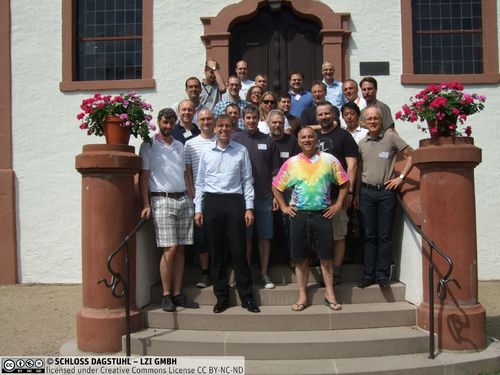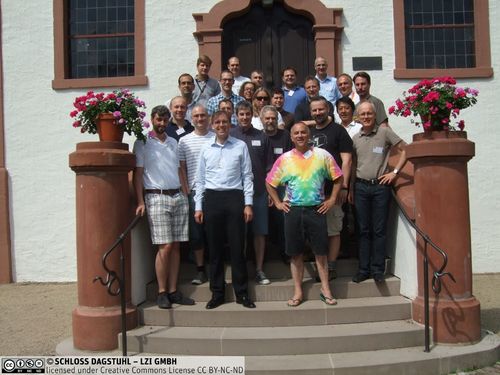Dagstuhl-Seminar 13322
The Critical Internet Infrastructure
( 04. Aug – 09. Aug, 2013 )
Permalink
Organisatoren
- Georg Carle (TU München, DE)
- Jochen Schiller (FU Berlin, DE)
- Steve Uhlig (Queen Mary University of London, GB)
- Walter Willinger (AT&T Labs Research - Florham Park, US)
Koordinator
- Matthias Wählisch (FU Berlin, DE)
Kontakt
- Andreas Dolzmann (für wissenschaftliche Fragen)
Programm
The Internet was designed to offer open data transfer services on a planetary scale. However, its success has turned it into a mission-critical infrastructure of vital importance for most countries, businesses, and industries. The aim of this seminar is to bring together the research and network operator communities to discuss and analyze the Internet as a critical infrastructure. We will address the vulnerability of the Internet from a number of different angles (e.g., physical infrastructure, control plane, data plane, services, etc.), with an emphasis on the core transport infrastructure as well as the content delivery side. The seminar will contribute to a better understanding of the Internet as a system of interdependent elements and pursue extensions of current research perspectives to consider novel (and maybe unusual) approaches to studying the local or region-specific substrates as parts of the Internet's global ecosystem.
Rethinking Perspectives on the Internet Backbone
Analyzing the mutual impact between ASes, the vulnerability and efficiency of the backbone requires the identification of ASes and their role in mutual transit. In particular, stakeholders do not want to ground their internal data exchange on weak third parties. In Internet terms, AS interconnections between key players of a country should be part of a transparently visible Internet ecosystem. However, the Internet is a globally distributed network without boundaries, which makes the identification of locally relevant subparts hard. This seminar aims at being a platform to leverage new and uncommon research perspectives that go beyond the Internet backbone as a globally distributed system.
Methodologies to Analyze the Internet Structure
To analyze the Internet as a critical infrastructure, a clear picture is required about the kind and granularity of data needed to obtain relevant results and draw valid conclusions, even if the available dataset is restricted. Sampling and inference are common methods to assess the impact of the limited view on the real Internet. Current approaches to model the Internet backbone need to be revisited to reflect the Internet as critical infrastructure. The mapping of logical Internet nodes (ASes) to concrete entities (companies, points of presence etc.) as well as its annotation with meta data (e.g., administrative contact points) have been identified as important to cover the Internet structure from a non-technical perspective.
Paradigms Overlaying IP Connectivity
Delivering content to the end users is one of the main objectives of the Internet. In the early Internet, end users accessed content directly from a primary source. With the advent of CDNs this has changed. A single CDN operates as replication and distribution network for many content publishers, which brings data closer and more efficiently to end users. In fact, a very large portion of the current Internet content is maintained by only a limited number of CDNs, creating a limited competition in this area. Until now, this oligarchy has not been thoroughly studied, especially in the context of the Internet as a critical infrastructure.
The research questions to be pursued and answered include:
- How can we define and extract a locally relevant view of the globally distributed Internet?
- Which metrics are appropriate to measure the importance of Internet stakeholders and their mutual relationships?
- Which countermeasures and improvements are feasible to protect the Internet as critical infrastructure without narrowing its flexibility and openness?
- To what extent can we analyze the Internet structure in short time frames?
- What is the role of specific ASes for reliably interconnecting the Internet infrastructure of a country?
- How can we reveal weak transits and unintentionally strong dependencies between ASes and specific regions of the world?
- How can we predict Internet scale consequences of large scale problems (what-if-questions)?
The Internet was designed to offer open data transfer services on a planetary scale. However, its success has turned it into a mission-critical infrastructure of vital importance for most countries, businesses, and industries. The aim of this seminar is to bring together the research and network operator communities to discuss and analyze the Internet as a critical infrastructure. We will address the vulnerability of the Internet from a number of different angles (e.g., physical infrastructure, control plane, data plane, services, etc.), with an emphasis on the core transport infrastructure as well as the content delivery side. The seminar will contribute to a better understanding of the Internet as a system of interdependent elements and pursue extensions of current research perspectives to consider novel (and maybe unusual) approaches to studying the local or region-specific substrates as parts of the Internet's global ecosystem.
Rethinking Perspectives on the Internet Backbone
Analyzing the mutual impact between ASes, the vulnerability and efficiency of the backbone requires the identification of ASes and their role in mutual transit. In particular, stakeholders do not want to ground their internal data exchange on weak third parties. In Internet terms, AS interconnections between key players of a country should be part of a transparently visible Internet ecosystem. However, the Internet is a globally distributed network without boundaries, which makes the identification of locally relevant subparts hard. This seminar aims at being a platform to leverage new and uncommon research perspectives that go beyond the Internet backbone as a globally distributed system.
Methodologies to Analyze the Internet Structure
To analyze the Internet as a critical infrastructure, a clear picture is required about the kind and granularity of data needed to obtain relevant results and draw valid conclusions, even if the available dataset is restricted. Sampling and inference are common methods to assess the impact of the limited view on the real Internet. Current approaches to model the Internet backbone need to be revisited to reflect the Internet as critical infrastructure. The mapping of logical Internet nodes (ASes) to concrete entities (companies, points of presence etc.) as well as its annotation with meta data (e.g., administrative contact points) have been identified as important to cover the Internet structure from a non-technical perspective.
Paradigms Overlaying IP Connectivity
Delivering content to the end users is one of the main objectives of the Internet. In the early Internet, end users accessed content directly from a primary source. With the advent of CDNs this has changed. A single CDN operates as replication and distribution network for many content publishers, which brings data closer and more efficiently to end users. In fact, a very large portion of the current Internet content is maintained by only a limited number of CDNs, creating a limited competition in this area. Until now, this oligarchy has not been thoroughly studied, especially in the context of the Internet as a critical infrastructure.
Original Goals of the Seminar
The research questions to be pursued and answered include:
- How can we define and extract a locally relevant view of the globally distributed Internet?
- Which metrics are appropriate to measure the importance of Internet stakeholders and their mutual relationships?
- Which countermeasures and improvements are feasible to protect the Internet as critical infrastructure without narrowing its flexibility and openness?
- To what extent can we analyze the Internet structure in short time frames?
- What is the role of specific ASes for reliably interconnecting the Internet infrastructure of a country?
- How can we reveal weak transits and unintentionally strong dependencies between ASes and specific regions of the world?
- How can we predict Internet scale consequences of large scale problems (what-if-questions)?
The complexity of the Internet makes it equally complex to give complete answers to these questions. This seminar helped us to start touching the questions. During our discussions it was clear that it is not only important to continue the work on these challenges but that it is also worth to follow up with a more specific focus on measurement aspects.
Acknowledgments
The editors of this report would like to thank all participants for very fruitful and open-minded discussions! In particular, we thank the operators for sharing practical insights.
We gratefully acknowledge the Dagstuhl staff for helping on all administrative coordination, for their patience, and most importantly for providing an extremely inspiring environment.
 Georg Carle and Jochen Schiller and Steve Uhlig and Walter Willinger and Matthias Wählisch
Georg Carle and Jochen Schiller and Steve Uhlig and Walter Willinger and Matthias Wählisch
- Bernhard Ager (ETH Zürich, CH) [dblp]
- Lothar Braun (TU München, DE) [dblp]
- Randy Bush (Internet Initiative Japan Inc. - Tokyo, JP) [dblp]
- Georg Carle (TU München, DE) [dblp]
- Nikolaos Chatzis (TU Berlin, DE) [dblp]
- Kenjiro Cho (Internet Initiative Japan Inc. - Tokyo, JP) [dblp]
- David Choffnes (Northeastern University - Boston, US) [dblp]
- Alberto Dainotti (San Diego Supercomputer Center, US) [dblp]
- Roland Dobbins (Arbor Networks - Singapore, SG)
- Anja Feldmann (TU Berlin, DE) [dblp]
- Timothy G. Griffin (University of Cambridge, GB) [dblp]
- Thomas Häberlen (ENISA - Athens, GR) [dblp]
- Ethan Katz-Bassett (University of Southern California - Los Angeles, US) [dblp]
- Stefan Katzenbeisser (TU Darmstadt, DE) [dblp]
- Rossella Mattioli (ENISA - Athens, GR)
- Matthew Roughan (University of Adelaide, AU) [dblp]
- Jochen Schiller (FU Berlin, DE) [dblp]
- Johann Schlamp (TU München, DE) [dblp]
- Thomas C. Schmidt (HAW - Hamburg, DE) [dblp]
- Yuval Shavitt (Tel Aviv University, IL) [dblp]
- Georgios Smaragdakis (T-Labs - Berlin DE & TU Berlin, DE) [dblp]
- Rade Stanojevic (Telefónica Research - Barcelona, ES) [dblp]
- Steve Uhlig (Queen Mary University of London, GB) [dblp]
- Matthias Wählisch (FU Berlin, DE) [dblp]
- Walter Willinger (AT&T Labs Research - Florham Park, US) [dblp]
- Bill Woodcock (PCH - San Francisco, US) [dblp]
Verwandte Seminare
- Dagstuhl-Seminar 17511: The Critical Internet Infrastructure Revisited (2017-12-17 - 2017-12-20) (Details)
Klassifikation
- modelling / simulation
- networks
- security / cryptology
Schlagworte
- Internet
- Backbone
- Internet Services
- Critical Infrastructure



 Creative Commons BY 3.0 Unported license
Creative Commons BY 3.0 Unported license
